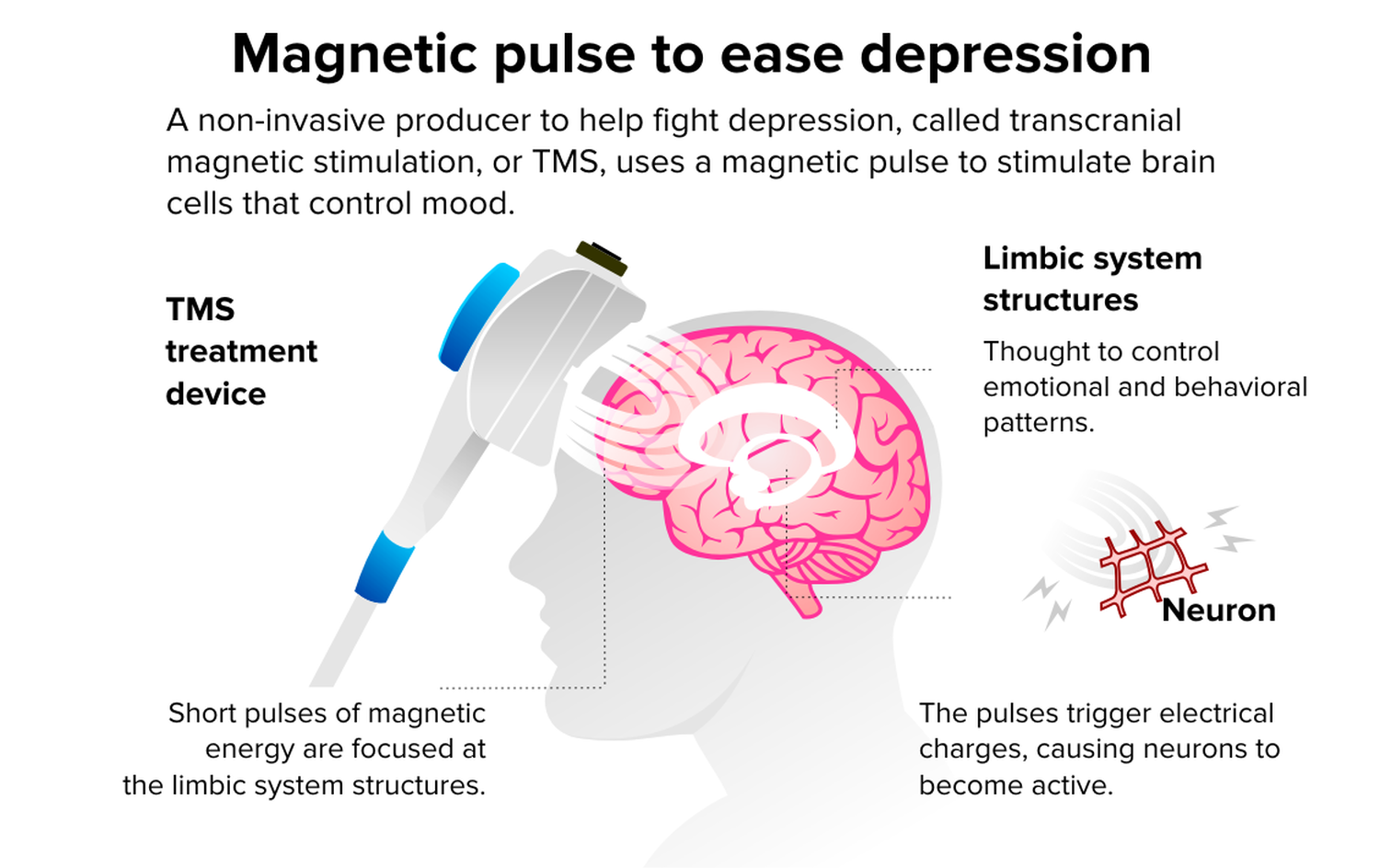With a DVA White Card, eligible veterans can access fully funded mental health care—no diagnosis or proof of service-related cause required. Support is just a step away. Click here.
About TMS
What is TMS?
Transcranial magnetic Stimulation (TMS) is a non-invasive procedure that uses magnetic fields to stimulate nerve cells in the brain to improve symptoms of depression.
TMS is typically used when other depression treatments haven’t been effective. TMS involved stimulation of an area of your brain using a pulsing magnet placed on your scalp. The magnet is designed to give a focused beam of magnetic energy inducing small electrical currents with the aim of altering brain function for therapeutic purposes.
TMS works by changing the brain electrical activity and the brain chemicals that are involved in controlling mood.
Why is TMS used?
Depression is a treatable condition. But for some people, standard treatments aren’t effective. Transcranial magnetic stimulation (TMS) is typically used when standard treatments such as medications and talk therapy (psychotherapy) are not effective.
TMS may be an appropriate treatment option for adult patients with treatment resistant major depression, who have failed to achieve a satisfactory response from prior trials of antidepressant medications (defined as “treatment resistant depression”).
The aim of TMS treatment is to lift your mood. With an improvement in mood there is often an associated improvement in sleep, appetite, energy and concentration and a decrease in negative thoughts. TMS is an acute treatment for depression and you will require ongoing treatment from your psychiatrist to maintain remission.
How does it work?
TMS treatment is a non-invasive treatment based on repetitive transcranial magnetic stimulation, which delivers magnetic pulses to stimulate nerve cells in the part of the brain controlling mood, which is often underactive in patients with depression.
The brain is an organ that functions through complex electrochemical processes, which may be impaired by certain types of mental illness. Scientists believe TMS acts by temporarily altering some of these processes, thereby returning function to normal.
TMS treatment delivers magnetic fields via a coil that is applied to one side of the patient’s scalp, generally above the left side of the head (above the dorsolateral pre-frontal cortex)

Repeated stimulation of this part of the brain has been proven to produce an antidepressant-like effect on people suffering from depression.
The magnetic field produces tiny electrical currents which then go on to activate cells within the brain, which (as believed) release neurotransmitters (chemicals in the brain), which do play an important role/function in mood regulation.
Since depression is believed to be caused by an imbalance of neurotransmitters/chemicals in the brain, TMS treatment helps restore the balance of these chemicals in the brain and goes on to relieve the symptoms of depression.
Costs of TMS
Costings
For private patients, each session costs $190. Initial course is 20 sessions but can be up to 30 sessions. Please give us a call to confirm this price.
Payment options
Payment can be made upfront or via an interest-free payment plan. Payment plans allow patients to pay for the costs of treatment over a period of time that suits their budget.
Private Health Insurance
Some private health insurance companies do cover outpatient TMS cost. You can contact your health fund directly to discuss this or we can arrange a health fund check once your referral has been received. Prior Approval from Health fund will be conducted by the hospital as there is required supporting patient documentation from the VMO.
Medicare rebates
Medicare rebates of 70-90%, approx $56.60 out of pocket. Upfront fee is $225 per treatment. RMT is $285 with $196.20 rebate ($88.40 out of pocket). Eligibility as per Medicare schedule.
Rebates are currently available for self-funding patients who are:
- First time recipients of TMS therapy
- Aged 18 years and older
- Diagnosis of a major depressive disorder
- Have trialled two different classes of anti-depressive medications
- Have had psychological therapy
- Doctors consultation and initial mapping/threshold fees apply. Medicare rebates also available
*DVA, WorkCover, and funds who are parts of the Alliance group may cover outpatient treatment on request
Superannuation
In some cases, patients may be able to access their superannuation on compassionate grounds in order to self-fund TMS treatment.